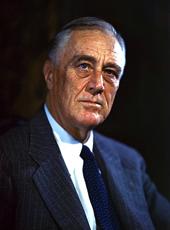President Rockefeller, friends of the Museum of Modern Art:
When men dedicate a new edifice for a common enterprise they are at once celebrating an achievement and announcing a purpose. They cannot refrain nor could they properly be excused from making clear what that purpose is.
From all that has been said by the speakers to whom we have been listening tonight the mission of this Museum is plain. We are dedicating this building to the cause of peace and to the pursuits of peace. The arts that ennoble and refine life flourish only in the atmosphere of peace. And in this hour of dedication we are glad again to bear witness before all the world to our faith in the sanctity of free institutions. For we know that only where men are free can the arts flourish and the civilization of national culture reach full flower.
The arts cannot thrive except where men are free to be themselves and to be in charge of the discipline of their own energies and ardors. The conditions for democracy and for art are one and the same. What we call liberty in politics results in freedom in the arts. There can be no vitality in the works gathered in a museum unless there exists the right of spontaneous life in the society in which the arts are nourished.
A world turned into a stereotype, a society converted into a regiment, a life translated into a routine, make it difficult for either art or artists to survive. Crush individuality in society and you crush art as well. Nourish the conditions of a free life and you nourish the arts, too.
In encouraging the creation and enjoyment of beautiful things we are furthering democracy itself. That is why this Museum is a citadel of civilization.
As the Museum of Modern Art is a living museum, not a collection of curious and interesting objects, it can, therefore, become an integral part of our democratic institutions—it can be woven into the very warp and woof of our democracy. Because it has been conceived as a national institution the Museum can enrich and invigorate our cultural life by bringing he best of modern art to all of the American people. This, I am gratified to learn, will be done through the traveling exhibitions of the Museum.
It is most important that the Museum make these traveling exhibits an essential part of its work. By this means the gap between the artists and American industry, and the great American public, can be bridged. And most important of all, the standards of American taste will inevitably be raised by thus bringing into far-flung communities results of the latest and finest achievements in all the arts.
These traveling exhibits will extend the perspective of the general public which too often has been accustomed to think of the fine arts as painting, and possibly sculpture. But the proposed traveling exhibitions and nationwide shows will make all of our people increasingly aware of the enormous importance of contemporary industrial design, architecture, including the great social art—housing—which by its very nature is one of the most formidable challenges to a democracy, as well as photography, the printed book, the illustration, the advertisement, the poster, the theater, and the moving picture. Thus, a nationwide public will receive a demonstration of the force and scope of all these branches of the visual arts.
Art in America has always belonged to the people and has never been the property of an academy or a class. The great Treasury Projects, through which our public buildings are being decorated, are an excellent example of the continuity of this tradition. The Federal Art Project of the Works Progress Administration is a practical relief project which also emphasizes the best tradition of the democratic spirit. The WPA artist, in rendering his own impression of things, speaks also for the spirit of his fellow countrymen everywhere. I think the WPA artist exemplifies with great force the essential place which the arts have in a democratic society such as ours.
In the future we must seek more widespread popular understanding and appreciation of the arts. Many of our great cities provide the facilities for such appreciation. But we all know that because of their lack of size and riches the smaller communities are in most cases denied this opportunity. That is why I give special emphasis to the need of giving these smaller communities the visual chance to get to know modern art.
As in our democracy we enjoy the right to believe in different religious creeds or in none, so can American artists express themselves with complete freedom from the strictures of dead artistic tradition or political ideology. While American artists have discovered a new obligation to the society in which they live, they have no compulsion to be limited in method or manner of expression.
The opportunity before the Museum of Modem Art is as broad as the whole United States. I trust that the fine example which this institution is affording will be widely copied and that the good work will continue until the influence of the best and the noblest in the fine arts permeates every community in the land.
Franklin D. Roosevelt, Radio Dedication of the Museum of Modern Art, New York City. Online by Gerhard Peters and John T. Woolley, The American Presidency Project https://www.presidency.ucsb.edu/node/209668


